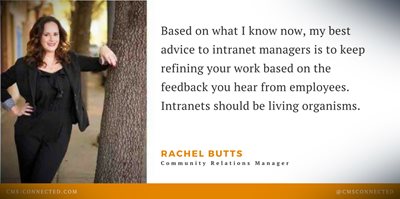Tales from the Other Side of the Intranet
Communications departments are unique within the corporate structure. They have a seat at more tables  than most – from executive level meetings to the front line employee experience. It is the responsibility of corporate communicators to understand the wants and needs of the full range of leaders and employees. Not only must they understand, but they must translate, lobby and engage individuals across this spectrum to help companies succeed.
than most – from executive level meetings to the front line employee experience. It is the responsibility of corporate communicators to understand the wants and needs of the full range of leaders and employees. Not only must they understand, but they must translate, lobby and engage individuals across this spectrum to help companies succeed.
For most of my career to this point, I sat in this unique spot. I felt that the single most powerful technological tool I had at my disposal was the company intranet. So much of my time was focused on making the corporate intranet a valuable resource for employees and leaders. From tracking down outdated content to writing compelling stories to updating site navigation, managing the intranet could have been a job all on its own. It’s a big, exciting job which keeps a person connected to the all the work being done in an organization.
In my current role, I am sitting in a very different spot. I am now on the front line, managing relationships and growing the business. I am an intranet user now, no longer an intranet manager.
I’ve learned a thing or two in my time as an end-user that has sharpened my perspective with regard to intranets and their best use.
1. Intranets communicate to employees what their role should include.
Visually engaging intranets containing narrative content to indicate to employees that work is about more than accomplishing tasks. This type of intranet welcomes employees into the story of their workplace and supports a connected and social culture.
Task-oriented employee portals empower individuals to access what they need when they need it to do their job. Intranets focused on efficiency often become “link farms” and have little to no visual engagement or narrative content.
2. Keep it simple silly.
Every company has its own language – its own way of speaking about the work it does. Using jargon or highly specialized terms in intranet navigation menus can create inefficiency, especially for a new employee who doesn’t realize that the content in a certain menu could help them in their role because they are unfamiliar with the terminology. By using common words and phrases in site navigation, more employees will be able to make use of more content, more easily.
3. Organization is king.
New employees are often overwhelmed with all they have to learn – from what’s expected of them to how to fit in with their team. A well-organized intranet will enable an employee to find what they need quickly and easily, so they can focus their efforts and brain power on other activities. If a new employee encounters an unorganized intranet and can’t find what they are looking for, they are unlikely to come back to the site unless they absolutely have to.
I think the biggest lesson I’ve learned from my time on the “other side of the intranet” is that even though I worked very hard to immerse myself in the employee experience as a corporate communicator, I couldn’t really understand it until I sat in the spot of a front line employee.
Based on what I know now, my best advice to intranet managers is to keep refining your work based on the feedback you hear from employees. Intranets should be living organisms.
And my best advice to intranet users is to actively use what you’re given to do your best, and be open about what you need, so the ones on the other side of the intranet can help.
If you would like to hear from Rachel Butts more on employee journey, tune into the featured topic segment of CMS-Connected Show aired on April 29th as she discussed the building blocks of a successful employee journey with analysts Scott Liewehr, Founder and CEO of Digital Clarity Group and Jeff Willinger, Director of Collaboration, Social Business and Intranets at Rightpoint.

Rachel Williams
Rachel Williams is a dot connector and story teller. In her current role as the Client Development Manager at EMERGICON, a Texans-serving-Texans emergency medical billing company, she is using her background as a communicator to help Texas Fire and EMS departments receive the reimbursements they earn so they can continue to serve their communities. She strategically employs technology to connect, educate and inspire colleagues and clients in an industry about which she is passionate.